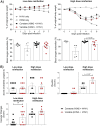Glycemic Variability in Diabetes Increases the Severity of Influenza
- PMID: 32209691
- PMCID: PMC7157527
- DOI: 10.1128/mBio.02841-19
Glycemic Variability in Diabetes Increases the Severity of Influenza
Abstract
People with diabetes are two times more likely to die from influenza than people with no underlying medical condition. The mechanisms underlying this susceptibility are poorly understood. In healthy individuals, small and short-lived postprandial peaks in blood glucose levels occur. In diabetes mellitus, these fluctuations become greater and more frequent. This glycemic variability is associated with oxidative stress and hyperinflammation. However, the contribution of glycemic variability to the pathogenesis of influenza A virus (IAV) has not been explored. Here, we used an in vitro model of the pulmonary epithelial-endothelial barrier and novel murine models to investigate the role of glycemic variability in influenza severity. In vitro, a history of glycemic variability significantly increased influenza-driven cell death and destruction of the epithelial-endothelial barrier. In vivo, influenza virus-infected mice with a history of glycemic variability lost significantly more body weight than mice with constant blood glucose levels. This increased disease severity was associated with markers of oxidative stress and hyperinflammation both in vitro and in vivo Together, these results provide the first indication that glycemic variability may help drive the increased risk of severe influenza in people with diabetes mellitus.IMPORTANCE Every winter, people with diabetes are at increased risk of severe influenza. At present, the mechanisms that cause this increased susceptibility are unclear. Here, we show that the fluctuations in blood glucose levels common in people with diabetes are associated with severe influenza. These data suggest that glycemic stability could become a greater clinical priority for patients with diabetes during outbreaks of influenza.
Keywords: blood glucose; diabetes; influenza.
Copyright © 2020 Marshall et al.
Figures







References
Publication types
MeSH terms
Substances
Grants and funding
LinkOut - more resources
Full Text Sources
Medical

